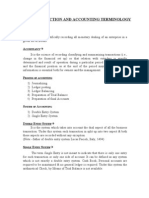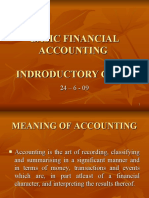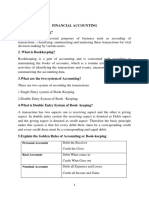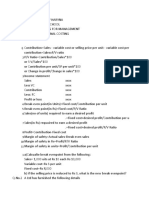0 ratings0% found this document useful (0 votes)
42 viewsAccounting Basics
Accounting for managers
Uploaded by
kanikaCopyright
© © All Rights Reserved
Available Formats
Download as PDF or read online on Scribd
0 ratings0% found this document useful (0 votes)
42 viewsAccounting Basics
Accounting for managers
Uploaded by
kanikaCopyright
© © All Rights Reserved
Available Formats
Download as PDF or read online on Scribd
You are on page 1/ 7
10/Accounting for Managers
ling, but the same book
i hhased frequently for rese *
eats cae aa cae
money with a fair return on it. (is cepts wen ii
s to the amount ofc y the
Drawings Drawing refer personal needs. Generally Personal drain
made in anticipation ofthe future profits, and are debited to the capil
"Gj" Acceants An afcoue tele’ sanininy of sao poe transaction aig
jeular person, asset, income, expenditure fo of tine
Sa Ci i ac tk
account etc.
15)
ACCOUNTING EQUATION
iness needs money to start its activities. The proprietor of the business, introg,
capital o sequre the areca a 4 business. If the capital introduced is not sutfieigy .
the required assets, then some funds are borrowed from outside sources. Pra
tis quite clear that there are two types of equities viz., intemal and exter; Internat
Cauity is the capital introduced by the owner(s) in business whereas external equities (also
Known as liabilities) ae the funds borrowed by a business from external sources such
creditors etc. Therefore, the resources can be provided either by the owner ot I. Silty
holders.
Accounting equation means recording of entries in a way that the assets equal equities,
The accounting equation can also be called as “law of equality of assets and equities of
balance sheet equation”. There should be equality between the total assets ang the total
es at any point of time. This equation also helps a business to know the profit
Assets = Owner's Equity + Liabilities,
This is the basic accounting equation on which the double entry accounting is built
UP Suppose, the owner invests Rs.50000 in a business in cach, the accounting equation is
Assets = Liabilities + Equity
Cash Capital
s.50000 = 0 + Rs.s0000
Now, if the business borrows Rs.25000 as loan from a bank, then the accounting
equation will be:
Assets = Liabilities + Equity
Cash Loan from bank Capital
Rs.75000 = Rs.25000 + Rssoo00
ILLUSTRATION 1
A business has total assets of Rs.250000 and liabilities of Rs.140000, Find out the
capital.
Solution:
Or Rss.250000~Rs.1400
ILLUSTRATION 2
Find out the liabilities ifthe assets are Rs.75000 and the capital is Rs. 50000.
Solution:.
Liabilities = Assets ~ Capital
Introduction to Accounting / 1)
{.¢., 8.75000 ~ Rs,50000 » Rs.25000
ILLUSTRATION 3
Find the value of assets, if the capital is Rs.65000 and liabilities are Rs.35000
Solution:
Assets = Capital + Liabilities
Or Rs.65000 +Rs,35000 = Rs, 100000
ILLUSTRATION 4
Let us see as to how the different transactions are analyzed using the accounting
equation,
1, Raju_ commences business and introduced Rs.150000 as his capital
Assets
Transaction effect Cash = Raju’s Capital
150000 = 150000
+ Capi
New balance 150000 = 150000
2. Deposited into the bank Rs.75000
Assets = Liabilities “+ Capital
Cash + Bank Raju’s Capital
Old balance 150000 = 150000
Transaction effect —75000+75000 =
75000-+75000
3. A machinery was purchased for Rs.50000
Assets jz
Cash + Bank
+ machinery = Raju's Capital
Old Balance 75000-+75000
‘Transaction effect 50000 + 50000 = 150000
New balance 25000-+75000+ 50000 = 150000
Furniture purchased by cheque Rs.20000
Liabilities + Capital
Cash + Bank
+ Machinery 7 Raju’s Capital
+ Furniture
Old balance 25000+75000+50000 = 150000
Transaction effect ~20000+20000 .
New Balance 2500055000 +5000 = 150000
+2000
y fr Managers
s/Accwuntlng a i
\ tv orth Re, 18000 on CH ae —
Cool
; + Raju's ¢
Cosh | Bank + are are
achinery
: Furniture + Stock
25000 + 75000 # a
ON balance 20 sie a
4200000 35000
‘Transaction effect
5000 + 75000 + S000
evans +2000 + 35000
= 33000 N04,
Rules of accounting equation
[sass [on
Credit Credit Debit Creda
Debit Debit Credit
eT |
Increase
Decrease
EMS OF BOOK KEEPING
We have already discussed the meaning of book keeping at the beginning. with
teapot tothe systems of book keeping, there are two systems, They are single entry system
‘and double entry system, :
SINGLE ENTRY SYS1
single entry system of bookkeeping is a system under
both the aspects of n transaction is not made, Sin
tecorded in the books most of the times,
‘Srantoee ofthis system i that ii simple,
iples and thus very scientific in its
lows the dep nttiNg concept of dual aspect 1
B credit, Under double enti
i) Tecorded. For instanes, ptct™ both the
(ie, debit and cred
business receives the Boods, WI
i debited and ir rer gh, 338 OF cash
kan tlentific and a reliable syste son, retum gives cash, which is credited. It
Aaovledge of the rues and he Pringle PS who folowe ms
the final accour
the business,
It should be Noted that, De
Ieee, , Double NITY syst
sires gm er ee en he wn
shoud be gc PBOME Sides tora eye amount, |g ie debe neo
From the above it js NOW crys erence
4 transaction tice, once
tal cl
ert aS8et oF a Of the debit ; ouble entry system of book-keeping
"gives an insight ec" OF revenug receigtit OM the credit side, The ens
mothe debit and creda the MEM. The where is thi
‘ous transactions,
ples,
inls are made which depicts the ay fi
one entry
record
introdvtion to Accounting /13
DEBIT cREDIT
Receipts Payments = —— Cash book
Cost / Expense Revenue ——~ Profit and loss Account
Assets Equities —— _ Balance Sheet
erence ET WEEN SIGE NTR SYSTEM AND DOUBLEENT ST
tems are as follows:
The differences between these two sys!
Double entry system
It and costly.
‘Single entry system
1. Itis simple and economical. Litt at
2 It is unscientific and unreliable. 2. itis scientific and reliable.
3. Only one aspect of a transaction is 3, Both the aspects of 8
recorded. transaction are .
4, Arithmetical accuracy cannot be 4, Arithmetical accuracy can be checked.
checked. =
5 True profit and financial position 5. Tue profit and financial position can be
cannot be known. known. 5
6. It involves less clerical work. 6. Irinvolves more clerical work.
STAGES OF DOUBLE ENTRY ‘SYSTEM
‘The following are the three sta; of a double entry system
: ber al or in subsidiary books
(1) All the transactions should be recorded in either in jour i
(Ge. in the books of original entry) as ‘and when they take place. This process iS
called journalizing or entering. "
(Q) All the entries in the journal or subsidiary books should be posted to the concerned
‘books of final entry) to find out the final effect of such
ledger accounts (ie. in the
transactions in a particular account.
G) The ion of profit and loss account i to ascertain the trading result and the
seeeer sheet to know the financial position of the business. In other words
losing the books of accounts and preparing final accounts. =
NATURE OF ACCOUNTING
“There are certain things common to every business, Every business enfers into contract
‘hove transactions are recorded in books under personal account
rties or assets such as building,
Igain every business ovns or possesses certain prope
agai ev cash ete. fr carrying on its activites. These assets are recorded separately under
sare at. Finally each business eams incomes and incurs expenses of different types.
a aeeeh income and expense account is opened in books under nominal account.
TYPES OF ACCOUNTING
From the above, one can
namely:
(1)Personal Account
(2)Real Account and
(3)Nominal Account.
Evovy business transaction has two aspects i. the receiving aspect and the giving
aspect. The receiving aspect is debited while the giving aspect is credited. Fe r
wen the goods are purchased for cash, purchase (Le, receiving aspect) ' chi, wheres
Cash (ie. giving aspect is credited, ‘The cash paid is equal to the value of goods purchased.
clearly understand that there are three types of accounts
- CW acm
JarAccounting fr Manne tie deel ta “oa
1 hero :
Jou entry ayater [4 1 9yAle
Vs the dole et
and equal ered sepa
Impersonal Accounts,
Personal Accounts
Rey Aecwmts Nomi Accany
Expenses Inga”
‘ ‘Taible Intangible i
Natl Repeat Tangle Inang Account Accong
Account Agcount Account if
Include the necounts of persons with yh
sonal Account: Personal accounts include tt
the Dewan ais In Other words, it is the account of persons ts ree husines
deals. There are three types of Personal accounts. (a) Natural aa 7 human
beings such as Mr. Akbar, Mr. Anil, Miss Aishwarya ete. (b) Artifictal persons include
account of business firms, government bodies, clubs, religious institutions, banks,
Dat not paid to workers.
2) Real Account: Real account represents the ac
may oe sourees owned by a concern with which the busi
3) Nominat Account: Nominal Accounts are th
: a i ©
mans oF a business, ‘These ane Opened 10 explain the nano
really exist and cannot be Seen. Example salary, rent,
RULES OF ACCouNTs
Personal Account: Debit the receiver
Credit the giver
Real Account; ei What comes in
Ht What goes out
Nominal Account; Debit all ex
It Penses ay
rei ios an :
Introduction 10 Accounting 115
SOME IMPORTANT ITEMS OF THE TYPES O¥ ACCOUNTS
Personal Account Real Account
audit
Let us take an example to understand how the transactions are debi
taking into consideration the accounts involved, the type of account and
debited and credited.
Transactions | Accounts
Involved
Real Account
Personal account
Personal account| Debit the receiver
Real account | Credit what
goes out
Cash Account
Capital Account
Capital
Introduced
Bank account
Cash account
Deposited
into bank
Real account
Personal
account
Sold
machinery
by cheque
Machinery
Bank account
account
in
Credit the giver
‘Nominal account
Personal account
Debit all expenses
Paid salary | Salary account
Credit the giver
Bank account
Cash account
Dividend
Real account Debit what comes
‘Nominal account |in
Dividend
Nominal Account
T human beings Sole Cash, stock, Land and Tent, Wages, Salaries
Itrading. partnership, Building, furniture and discount, commission
JCompany, club, hospital, fittings, vehicle, plant and paid or received,
college, university, Govt. ete machinery ete Hebts, depreciation,
fees, catriagey freight ec)
Bank account
Cash account
|_
Puchased | Building account| Real account Debit what comes | Machinery
building for | Cash account | Real account in account
cash Credit what Cash account
goes out
Debit what comes | Machinery
‘Cash account
ited and credited,
the account to be
| account Credit all incomes | account
LLUSTRATION 4 ah
Classify the following into (a) Personal account (b) Real account and (©) Nominal
account.
| (1) Capital Account
(2) Bank Account
(3) Furniture Account
(4) Cash Account
(5) Commission Account
(6) Purchases Account
(7) Rent Account
(8) Building Account
(9) Goodwill Account
| (10) Salaries Account
(11) Creditors Account
a
neg maar
16/Accounting for Managers
(12) Investment Account
(13) Stock Account I
4) Rahman's Account,
(15) Bangalore Universi Account
Solution:
(4) Real
1) Personal (2) Personal (3) Real (2,
{nomi (7) Nominal (8) Real (9) Real ( 19, \otminay
(11) Personal (12) Real (13)Real (14) Personal Noms
Summary
: is ration of
ing and preparat its et Words, accountin forma fo
requires a higher ieelen neta, con etaton and — is ima : =
Pant of an accountant, raintgge tual understandin, the resue
OF reasons ike pron, ee fr 7 ete
"Which ames manner
, we allmenetary transactions
San a
)
fy Overs are yor ation " Mature ang oe ay otra
——— analysis of the past
fo eetation,
ai i 'S of a busi
Fecoveran’ 8Ccruay basis are oer etn Of facts and gues.
Teoma "Pope h aia" account
You might also like
- Introduction To Financial Accounting For Iipm: R.S.Sivaraman Chartered AccountantNo ratings yetIntroduction To Financial Accounting For Iipm: R.S.Sivaraman Chartered Accountant46 pages
- Accounting & Finance Module: B: Ca R. C. JoshiNo ratings yetAccounting & Finance Module: B: Ca R. C. Joshi131 pages
- Financial Accounting - An Ice Breaker: BY: Mohit Dhawan Asst. Prof. (Finance) & Asst. Dean (MGT.) INMANTEC, GhaziabadNo ratings yetFinancial Accounting - An Ice Breaker: BY: Mohit Dhawan Asst. Prof. (Finance) & Asst. Dean (MGT.) INMANTEC, Ghaziabad64 pages
- Notes of Double Entry System and Journal Entry100% (1)Notes of Double Entry System and Journal Entry35 pages
- Basics of Accounting in Simlified MannerNo ratings yetBasics of Accounting in Simlified Manner15 pages
- Basic Accounting Concepts, Conventions, Bases & Policies, Concept of Balance Sheet86% (7)Basic Accounting Concepts, Conventions, Bases & Policies, Concept of Balance Sheet44 pages
- Accounting Training: Confidential PresentationNo ratings yetAccounting Training: Confidential Presentation74 pages
- Basics of Accounting Till Balance SheetNo ratings yetBasics of Accounting Till Balance Sheet39 pages
- Presented By: Prof. T. R. Anand: Book Keeping and AccountancyNo ratings yetPresented By: Prof. T. R. Anand: Book Keeping and Accountancy26 pages
- Basics of Accounting: Chanakya Introduced The Accounting Concepts in His Book Arthashastra. in His Book, He100% (1)Basics of Accounting: Chanakya Introduced The Accounting Concepts in His Book Arthashastra. in His Book, He15 pages
- Accounting For Managers: Basics of Business Accounting (Learner Friendly Approach)No ratings yetAccounting For Managers: Basics of Business Accounting (Learner Friendly Approach)45 pages
- Introduction of Book Keeping & AccountancyNo ratings yetIntroduction of Book Keeping & Accountancy33 pages
- AFM-Module 4 Part-B Ratio Analysis ProblemsNo ratings yetAFM-Module 4 Part-B Ratio Analysis Problems5 pages
- Introduction To Financial Accounting For Iipm: R.S.Sivaraman Chartered AccountantIntroduction To Financial Accounting For Iipm: R.S.Sivaraman Chartered Accountant
- Financial Accounting - An Ice Breaker: BY: Mohit Dhawan Asst. Prof. (Finance) & Asst. Dean (MGT.) INMANTEC, GhaziabadFinancial Accounting - An Ice Breaker: BY: Mohit Dhawan Asst. Prof. (Finance) & Asst. Dean (MGT.) INMANTEC, Ghaziabad
- Basic Accounting Concepts, Conventions, Bases & Policies, Concept of Balance SheetBasic Accounting Concepts, Conventions, Bases & Policies, Concept of Balance Sheet
- Presented By: Prof. T. R. Anand: Book Keeping and AccountancyPresented By: Prof. T. R. Anand: Book Keeping and Accountancy
- Basics of Accounting: Chanakya Introduced The Accounting Concepts in His Book Arthashastra. in His Book, HeBasics of Accounting: Chanakya Introduced The Accounting Concepts in His Book Arthashastra. in His Book, He
- Accounting For Managers: Basics of Business Accounting (Learner Friendly Approach)Accounting For Managers: Basics of Business Accounting (Learner Friendly Approach)

































































